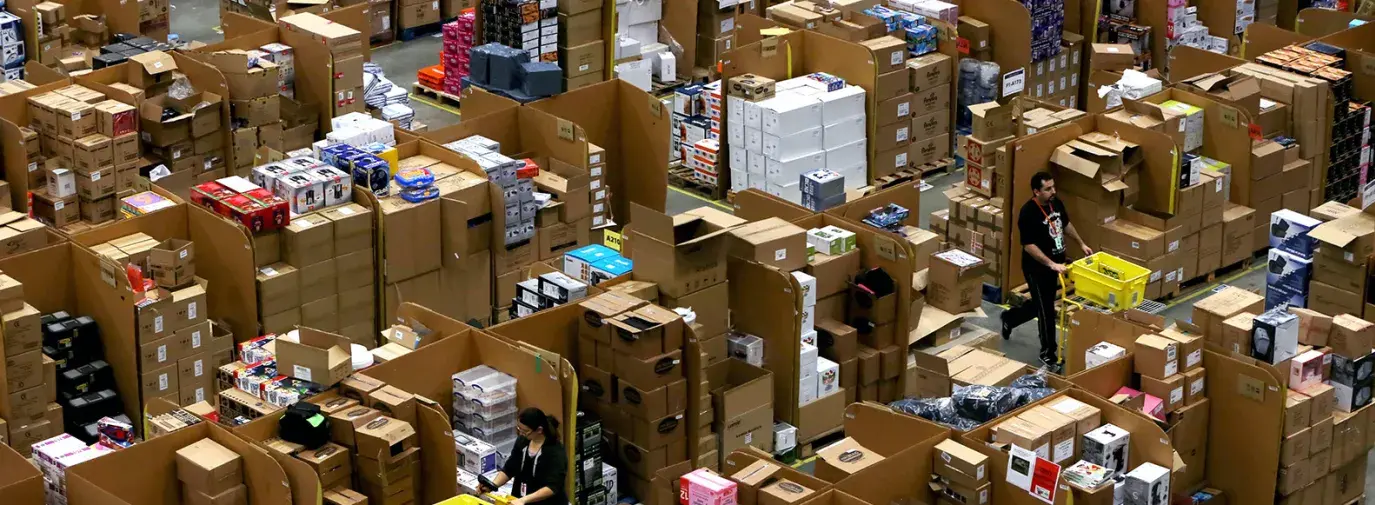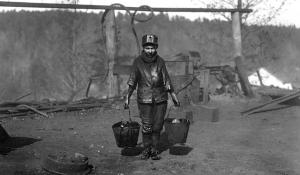
Amazon continues to grow in popularity for its low prices and fast delivery. But warehouse workers behind the scenes are paying for it all with bottom-level salaries and back-breaking work.
In cities across the country, people are waiting with bated breath to see where online retail giant Amazon will build its planned second headquarters, because they’re hungry for the 50,000 jobs the company says it will add as part of the expansion.
Amazon has already busted out of its headquarter city of Seattle. It has 75 fulfillment centers across the US employing 125,000 full-time workers, according to company reports, with hundreds of other locations and hundreds of thousands more employees around the world. But what goes on behind the closed doors of those fulfillment centers—and thousands like them owned by other companies—is a dangerous business.
Temporary Workers, Permanent Problem
After the labor movement of the 1940s and ’50s, warehouses jobs were stable, paid enough to support a family, and offered benefits. But in the following decades, costs fell as companies outsourced manufacturing, and box stores saw they could increase profit by paying US warehouse workers less, too.
Temporary workers are now standard in the industry—an organizer in Southern California says up to 40 percent of warehouse jobs in the state’s Inland Valley region are temporary, and in Chicago, organizing group Warehouse Workers for Justice estimates more than 60 percent of the city’s 80,000 warehouse jobs are temporary. Chicago and L.A. are the biggest shipping hubs in the US.
Temporary workers provide companies with a more flexible labor force requiring fewer benefits than full-time, salaried employees. They are also a more “vulnerable workforce with unclear lines of accountability for health and safety,” states a 2018 report from the National Council for Occupational Safety and Health (COSH).
The way companies like Amazon and Walmart fulfill temp positions is through staffing agencies, which find, hire, and pay workers. This system prevents unionization—because not all jobs in one warehouse are for the same staffing company—and helps corporations save on health insurance and other costs.
Sheheryar Kaoosji is executive co-director at the Warehouse Worker Resource Center in Ontario, CA, a nonprofit that aims to improve working conditions in the Inland Valley of California, home to a large warehousing industry.
“There’s 80,000 jobs available [here], but because of the temp system, there might be 200,000 people flowing in and out of those jobs—they’re not fully employed,” explains Kaoosji. “It’s a key part of the ‘working poor’ economy in our region.”
He says workers who move to the Inland Valley, because of the lower cost of living and many job opportunities, end up scrambling to make ends meet.
“The warehouse worker population is almost entirely people of color, and it’s lots of people who are new to the community,” Kaoosji says. “It’s a lot of people ... who are trying to hang on and make a life for themselves. This region was promised that these jobs would be the future of the economy, and it’s not turning out to be that way.”
Humans Treated Like Machines
Ten percent of the warehouse jobs in the Inland Valley are at Amazon warehouses. Kaoosji says people must pay attention to Amazon because it draws in workers with wages a few dollars higher than minimum wage, and as one of the country’s largest retailers, it impacts how other companies treat their workers. [Editor’s note: Green America has a campaign pressuring Amazon to clean up its coal-powered cloud operations.]
Recently, workers have spoken out anonymously to various news sources about the bad conditions in Amazon’s warehouses. As orders come in via the Amazon website, workers called “pickers” retrieve items for orders from stocked warehouse shelves, putting them onto giant shopping carts and delivering to a boxing station. Amazon holds pickers to a steep piece rate, reported to be from 85-300 items per hour.
Pickers can be and have been fired for not making rate, and these workers complain of back and joint pain from bending, reaching, and being on their feet all day. Some workers report walking more than ten miles per shift through huge fulfillment centers.
Roberto Jesus Clack is an organizer with Warehouse Workers for Justice (WWJ) in Chicago. He says that Amazon’s goal is to provide the same instant gratification as department stores.
“Really, its goal is to be able to get people as many products as possible within the day, or even within a few hours of ordering,” Clack says. “There’s a ton of pressure on the workforce to always speed up, speed up. [WWJ is] really concerned about safety issues, and whether [workers are] being compensated appropriately for the value they add.”
Other reports make Amazon’s warehouses seem like sweatshops. Security checks to prevent worker theft are included in break times, so half-hour lunch breaks and timed bathroom breaks end up being shorter than promised. Employees have reported being written up for not showing up for overtime hours, which should be voluntary by law.
Since 2013, there have been seven fatalities among Amazon warehouse workers. In 2013, picker Jeff Lockhart Jr. died after collapsing during his overnight shift. A cardiologist who reviewed his autopsy said it was likely from overexertion. And last year, two workers were crushed by warehouse vehicles, calling into concern the safety procedures of both drivers and ground staff.
The Associated Press reported in November that Amazon could face $28,000 in fines from the Occupational Safety and Health Administration (OSHA) for safety violations that led to last year’s deaths, including a $7,000 fine for failure to provide training.
Earlier this year, Amazon made headlines when it was approved for a patent for a wristband that tracks workers’ movements. The wristband will buzz when a worker’s hand is close to the item they’re reaching for, to help reduce the time needed to locate the correct item on a crowded shelf.
Kaoosji, says the wristband is just the latest push in the company’s efforts to improve its employees’ piece rates.
“Amazon has a specific kind of problem that stems from its obsession with metrics, and because of technological advantages, their surveillance regime is about as good as it can get,” Kaoosji says. “They’re surveilling employees to watch exactly what they’re doing and how quickly they’re moving.”
That kind of constant pressure to meet ever higher fulfillment quotas has created a culture at Amazon warehouses where stressed-out employees forgo bathroom breaks or urinate in bottles, out of fear of being disciplined or losing their jobs, according to journalist James Bloodworth, who went undercover in a UK Amazon warehouse, the subject of his new book Hired: Six Months Undercover in Low Wage Britain (Atlantic Books, 2018).
Dangers of the “Lower-archy”
Many warehouse workers are afraid of losing their jobs if they report a safety violation or complain about conditions. Marcy Goldstein-Gelb, co-executive director at National COSH, describes the people who feel least comfortable speaking out, and who are the lowest-paid workers as a “lower-archy.”
“The lower you are, the fewer job options you have, the more that you risk if you speak up about a labor violation—be it health and safety or not being paid—and the less likely you are to feel comfortable speaking up,” Goldstein-Gelb says. “There’s a few factors that make you vulnerable: if you don’t speak English, if you’re younger, if you lack a union, if you’re a temporary worker. If you’re in a day-to-day situation where you could be fired for speaking out, then your life is at risk.”
National COSH and its regional groups are trying to make workplaces safer by training employees on what to look for to assess workplace safety, how to speak up if their workplaces aren’t safe, how to work with unions, and how to talk to communities about the importance of having strong safety laws and standards.
Consumers can help by telling their Congressional representatives to press for adequate staffing at OSHA, Goldstein-Gelb says. This federal agency can make workplaces comply with regulations for worker safety by sending in investigators who cite employers for violations. However, nearly 50 investigator positions have opened up and not been rehired since the beginning of Trump’s presidency. Goldstein-Gelb notes it would take the current number of investigators 140 years to look into all complaints that are on file right now (with no new ones added).
“In the ideal world, employers would simply want to have safe workplaces and do it on their own without any need for enforcement, but too often, we find that employers are cutting corners and trying to make a quick buck at the expense of workers,” Goldstein-Gelb says.
Support Warehouse Workers
Across the country, warehouse workers are organizing for better working conditions. Here’s how you can amplify their efforts:
- Support unions. Shopping at stores where the workers are unionized supports fair wages and safer workplaces. Instead of buying groceries at Amazon or Walmart, try union stores like Kroger or Albertson’s. Find one at ufcw.org/grocery. Find union-made products at unionlabel.org.
- Shop green and local. Avoid big-box and online retail giants like Amazon when you can, and shop with local, green businesses instead. Find those near you at GreenPages.org. And read our “11 Greener Options Than Amazon.”
- Support campaigns at warehouse worker organizations. Stay informed through Warehouse Workers for Justice, the Warehouse Workers Resource Center, and the National Council for Occupational Safety and Health.







